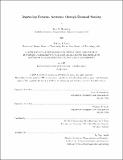| dc.description.abstract | This capstone assesses the feasibility and potential value of implementing Demand Sensing in the supply chain of a major consumer medical device company- Johnson & Johnson Vision Care. Specifically, we explore the potential benefits of incorporating downstream Supply Chain data into forecasting, reducing latency between Sales and Operations Planning (S&OP) cycles, and quantifying demand shaping actions. The motivation for this project was to find new sources of efficiency within a constrained production environment . Our approach was twofold: first, to statistically examine the accuracy of the current forecast system and second, to assess the pragmatism of Demand Sensing. The results of our statistical analysis suggest using alternative methods for forecasting slow-moving SKUs. Our research into advanced forecasting methods provide real world recommendations regarding the benefits and drawbacks of Demand Sensing approaches. We constructed three initiatives - one for each Demand Sensing approach - that can be used independently, or in any combination, to create a Demand Sensing forecasting system. The three initiatives are called Latency Reduction (LR), Downstream Data Integration (DDI), and Measuring the Impact of Demand Shaping Actions (DSA). | en_US |
